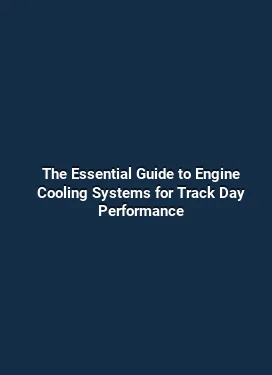How to Prevent Turbo Surge on Nissan Skyline GTR R34 RB26DETT
The RB26DETT engine powering the Nissan Skyline GT-R R34 is renowned for its robust performance and potential for high output. With great power comes the responsibility to manage air, fuel, and exhaust flows in harmony. Turbo surge, a compressor-related anomaly, can occur when the pressure ratio and airflow demand outpace the turbocharger’s ability to deliver. Understanding the mechanics behind surge and implementing targeted strategies can preserve turbo health, improve spool behavior, and maintain reliability under a wide range of driving conditions.
Understanding Turbo Surge in RB26DETT

Turbo surge is a fluttering or stuttering of the compressor wheel that happens when the intake airflow is insufficient to meet the compressor’s thrust at a given boost level. In practical terms, surge often occurs during rapid throttle transitions, aggressive gear changes, or when a mismatch exists between the turbocharger size, piping, intercooler capacity, and the engine’s fueling and ignition maps. The result can be excess backflow into the compressor, audible whines, and, over time, mechanical strain on the turbo seals and bearings.
For RB26DETT platforms, surge prevention hinges on maintaining stable positive pressure in the intake tract, ensuring the boost signal is well managed, and keeping the engine’s fueling and timing in sync with boost. A balanced system reduces pressure oscillations, keeps compressor maps within the efficient operating window, and minimizes risk to the turbocharger under both daily driving and high-load scenarios.
Makale içindeki ilk H3 başlık buraya gelmeli

At the heart of surge prevention is the proper sizing and tuning of the entire intake and boost control chain. This includes the turbocharger selection relative to the engine’s displacement and desired power range, the integrity of the intake piping and intercooler path, and the reliability of boost control components. If any element introduces excessive pressure drop or lag in response, the compressor can experience recirculation or surge under transient demands.
Additionally, a thorough understanding of airflow dynamics is essential. The RB26DETT benefits from a well-designed intake manifold, clean throttle body transitions, and a recirculating blow-off or dump valve that maintains pressure stability without introducing harmful backflow into the compressor during gear changes. High-velocity piping and carefully routed intercooler cores help preserve charge air temperature and density, further reducing surge risk.
Key Factors That Contribute to Turbo Surge
Addressing surge requires a holistic view of the entire air-path and control logic. The following factors are commonly implicated in surge behavior on a tuned RB26DETT platform:
- Boost control integrity: Inadequate or inconsistent boost signaling can cause rapid pressure fluctuations that trigger surge events. A precise control solenoid, proper vacuum lines, and leak-free connections are critical.
- Intercooler efficiency and charge cooling: A bottleneck in cooling raises intake air temperature, reducing density and destabilizing the pressure relationship across the compressor.
- Piping and intercooler layout: Sharp bends, long runs, or restrictive couplers increase pressure drop, encouraging backflow at the compressor wheel.
- Fueling and ignition synchronization: Lean or variable fueling can hamper the engine’s ability to meet the demand at boost onset, amplifying surge tendencies.
- Exhaust backpressure and turbine sizing: A turbine that is too small or operating near its choke point can drag boost, causing off-boost surges when the throttle is opened wide.
Understanding how these elements interplay helps in designing robust prevention strategies, rather than chasing symptoms after surge occurs. Each modification should be evaluated for its impact on the entire boost ecosystem, not in isolation.
Makale içindeki ilk H2 başlık buraya gelmeli
Practical testing methods reveal how real-world conditions influence surge. Realistic scenarios—such as launching from low RPM with high boost, executing rapid gear shifts on race fuel, or maintaining high-load cruise—provide insight into how your RB26DETT responds under pressure. A combination of data logging and careful listening to compressor whine and flutter can guide adjustments that reduce surge risk without compromising performance.
Strategies for Preventing Turbo Surge
Preventing surge involves a mix of hardware refinement, tuning practices, and maintenance discipline. The following approaches are commonly employed by enthusiasts and professionals when working with RB26DETT engines:
- Optimize boost control: Use a well-sealed boost control system with stable duty cycles and fast-acting solenoids. Calibrate pressure mapping to avoid abrupt spikes or drops during throttle transitions.
- Ensure robust vacuum integrity: Inspect all vacuum lines, check valves, and fittings for leaks. A single vent or cracked line can cause inaccurate boost readings and trigger surge conditions.
- Upgrade intercooler capacity and airflow: A high-efficiency intercooler with minimal pressure drop lowers charge air temperature and stabilizes pressure at the compressor inlet.
- Enhance charge piping and fittings: Use smooth-bore pipes, large-radius connections, and quality couplers to reduce turbulence and backflow paths feeding the compressor wheel during transient events.
- Refine fueling strategy: A properly mapped fuel delivery and ignition timing profile ensures the engine can meet the surge demand without running lean, which worsens surge risk.
- Calibrate a recirculating blow-off valve: A valve that vents to the intake or recirculates effectively dampens surge by moderating rapid pressure spikes when the throttle closes suddenly.
- Match turbo sizing to your goals: A turbo that’s too small may surge at high boost, while an oversized unit may exhibit lag. Aim for a compressor map that sits within the efficient region at your target operating envelope.
- Stabilize idle and low-load operation: Clean idle control and stable low-load fueling reduce the likelihood of surge during transitions from idle to light throttle.
Implementing these strategies requires a coordinated approach across the engine management system, turbo hardware, and the physical layout of the intake and exhaust paths. Each change should be validated on a dyno or with precise road logging to confirm that surge is mitigated under diverse driving conditions.
Makale içindeki ilk H3 başlık buraya gelmeli
In practice, a staged approach often yields the best results. Start with ensuring seal integrity and boost line accuracy, then verify intercooler performance under realistic airflow. If surge persists, gradually refine piping geometry and consider a turbo upgrade or turbine wheel rework that preserves compressor map integrity while delivering smoother boost delivery.
Diagnostic Approaches and Monitoring
Effective prevention rests on continuous monitoring and proactive diagnostics. The RB26DETT’s boost response, air-fuel ratio, and spark advance can be tracked with data logging tools that capture transient events. Key indicators to monitor include peak boost pressure, compressor surge events (typically observable as rapid pressure oscillations and audible flutter), and engine knock tendencies during boost onset.
Beyond data, listening for compressor flutter at the intake and observing throttle response during gear changes provide immediate feedback on system health. Visual inspection of the turbo housing and compressor wheel during service intervals can reveal signs of wear, boost leak paths, or seal degradation that contribute to surge risk over time.
Testing Scenarios to Validate Surge Prevention
Controlled testing is essential to validate the effectiveness of the implemented strategies. Consider the following scenarios to evaluate surge resilience:
- Steady-state boost testing across RPM bands to ensure the compressor operates within the efficient map region without flutter.
- Cold-start to hot-start transitions to verify boost stability during thermal shifts that influence air density and fueling.
- High-load acceleration in each gear to confirm that the system responds predictably under rapid throttle input.
- Throttle tip-in tests from partial throttle to wide-open throttle, observing how the boost controller and intercooler respond to sudden demand.
Documenting results with logs and aural cues helps refine the map and hardware setup. It also informs maintenance intervals, ensuring the RB26DETT remains responsive and reliable under demanding conditions.
Maintenance and Longevity Considerations
Preventing surge is not a one-time adjustment; it requires ongoing maintenance and periodic reassessment as the vehicle ages or as power goals evolve. Key longevity considerations include keeping compression rings and turbo seals in good condition, performing regular coolant and oil changes to preserve bearing lubrication, and inspecting intercooler cores for contaminants or degradation that can compromise cooling efficiency.
When planning modifications, document changes comprehensively. A well-documented build log helps diagnose surge-related issues more quickly and supports informed decisions about future upgrades or tuning directions. After major changes, re-baselining with dyno runs or road tests ensures the new configuration delivers the expected stability and performance.
Makale içindeki ilk H2 başlık buraya gelmeli
In summary, the RB26DETT benefits from a meticulously engineered boost path, precise control systems, and a cooling strategy that together reduce the likelihood of turbo surge. Each component—from the throttle body to the intercooler core, from the bleed valves to the ECU tune—plays a role in shaping how the engine meets demand without introducing pressure instability. This integrated approach yields smoother power delivery, improved throttle feel, and enhanced engine longevity for the Nissan Skyline GT-R R34 platform.






